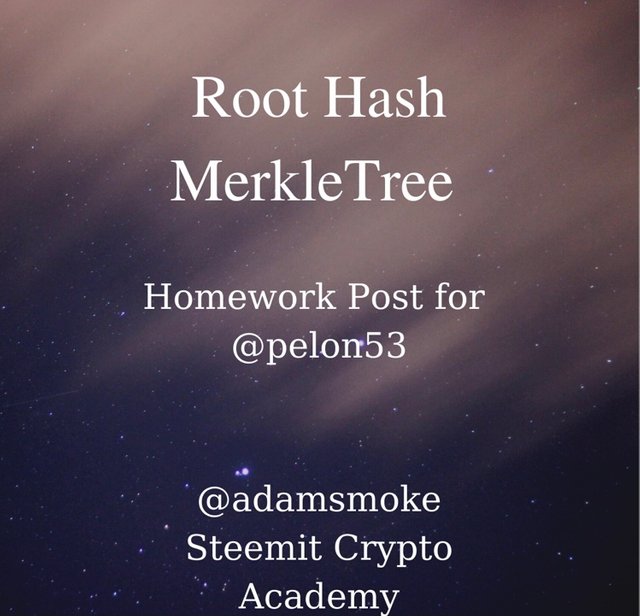
Introduction
Hello to everyone. This week's homework topic is hashe rate and the merkle tree. Thank you in advance to everyone who reads my homework. I wish you all a healthy and beautiful day

Questions 1
Explique en detalle el hash rate.
Hashe rate is also known as hash rate. Hashe rate refers to the operating speed of any device we are mining. Speed is a very important factor in mining. Mining devices make hundreds, thousands, millions of estimations per second.
Hash rate is also one of the most important elements of the blockchain world. It first appeared with the emergence of the first cryptocurrency (BTC).
Cryptocurrency mining involves creating blocks through many complex calculations. These blocks are like a mathematical problem. Mining devices make predictions of millions of transactions per second, as we said before.
Hashe rate is also a term used to measure the security and strength of a blockchain. For this reason, the higher the hash rate of any blockchain network, the stronger it will be against what we call a 51% attack. In short, the more miners you have, the stronger your blockchain network will be and the lower the hacking rate.
Hashe rate is expressed numerically as shown in the table below. Hash rate = calculated in hashes per second. (h/s).
• Kilo Hash : 1.000 hashes
• Mega Hash : 1,000,000 hashes
• Giga Hash : 1,000,000,000 hashes
• Tera Hash : 1,000,000,000,000, hash
• Peta Hash: 1,000,000,000,000,000 hashes
• Exa Hash : 1,000,000,000, 000,000,000, hash

Questions 2
Realice el siguiente Árbol Merkle:
Transacción (hojas del árbol): Steem1; Steem2; Steem3; Steem4; Steem5; Steem6; Steem7; Steem8.
Llegué hasta el Root Hash. Y coloque cada hash generado usando SHA-256, muestre captures de pantalla.
Diga los pasos a seguir para verificar si Steem6 está incluido en el Árbol Markle.
- first we go to https://passwordsgenerator.net/sha256-hash-generator/
- Next, we place the words as shown to us. Let's make sure we type the upper and lower case letters correctly, otherwise we won't be able to reach the correct hash value.
Steem1: 7760E25BCB80ADF1DD92DB339BF5790A59E90CD54EFA072F1250DCE13FA97045
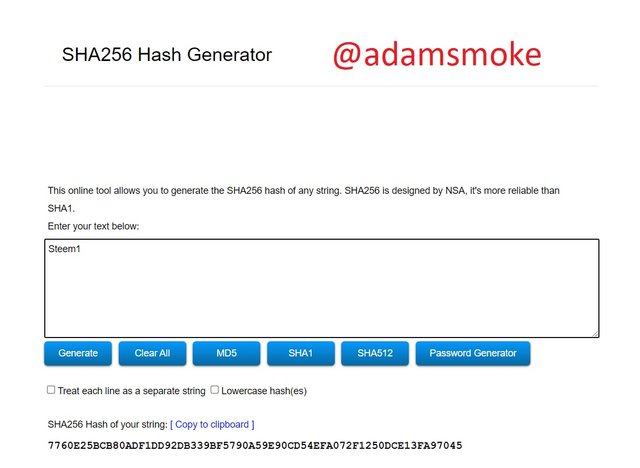
Steem2: FE00506E91CF52BC4B35321E6B978D1A7349397B19C6C1C01E095971FDEC9741
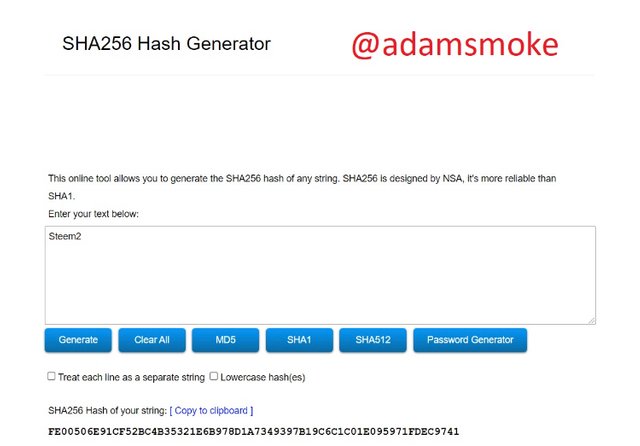
Steem3: A9418332E0C351D6A50C835AA9E57D514F0573C231D491E97726DB8A5844F2DC
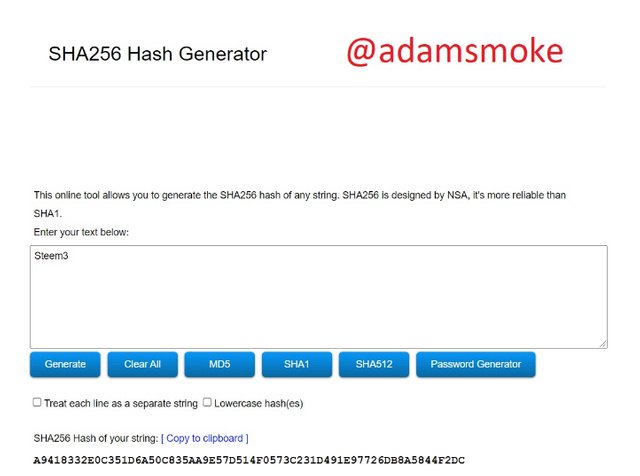
Steem4: 22F4EC8E20C9CCAF2C313B23F18981B1C73BF39081BCD739E5D998A95A46AB30
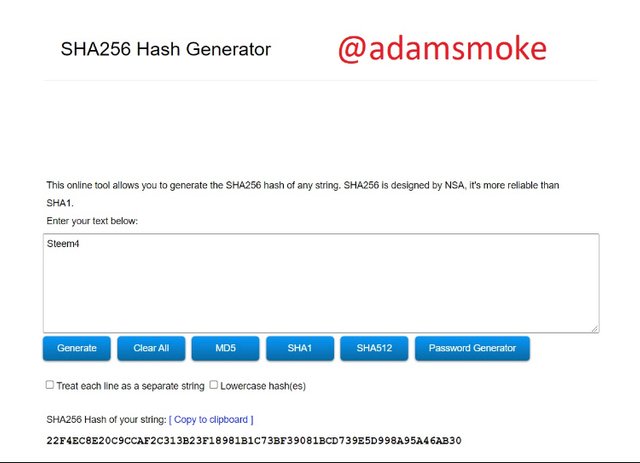
Steem5: 2A3C87336683AB0DDFA56AFEFC740E6C13A02FEA0A43D6797343B26D7AF0C57B
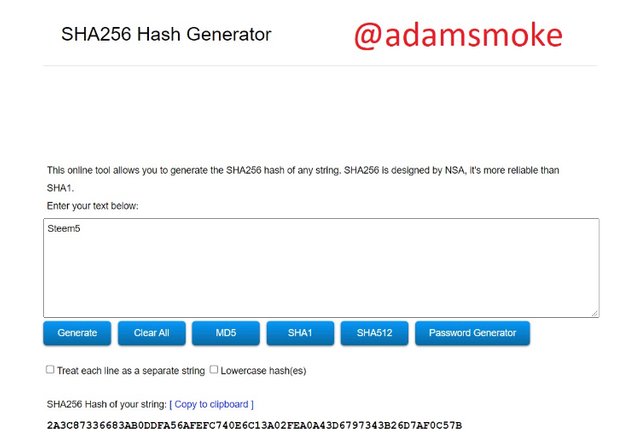
Steem6: A7BAA6DE0C0658E9E3681966E542BACD116529F5AE9A2D9126CDB1C1D5BC1278
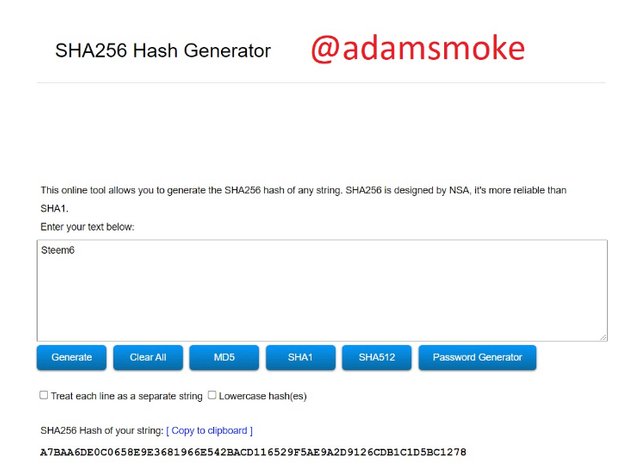
Steem7:
D441688DDA7F9285E8811728DD9A3955CF74F0A3C7600C1589D0F1D3B48FFAC7
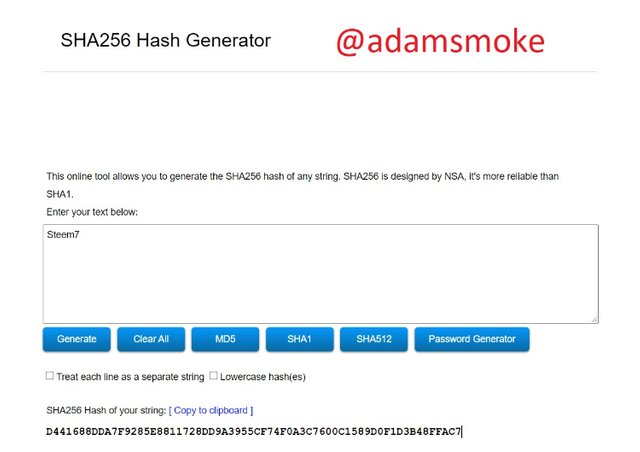
Steem8: F2E38ED4FF662087B6E9BEAFA4158EBC488B995732057BDA019A6A77FFB5F9F5
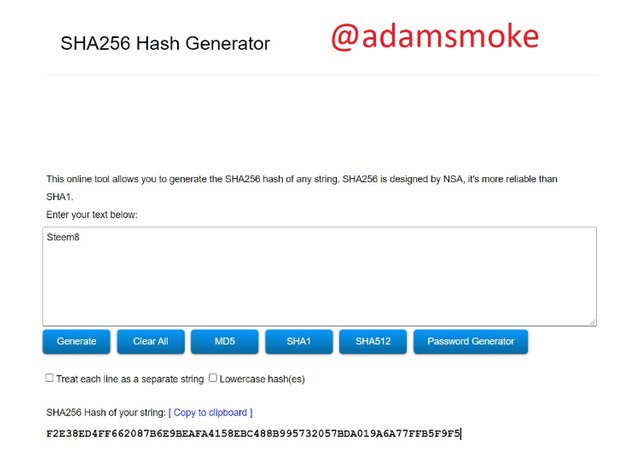
First Level Merkle Tree Branches
Steem1Steem2: A5568957014F6AC3866923C7DE20D375E706B8D8C9F453636E90B9965ABEC62B
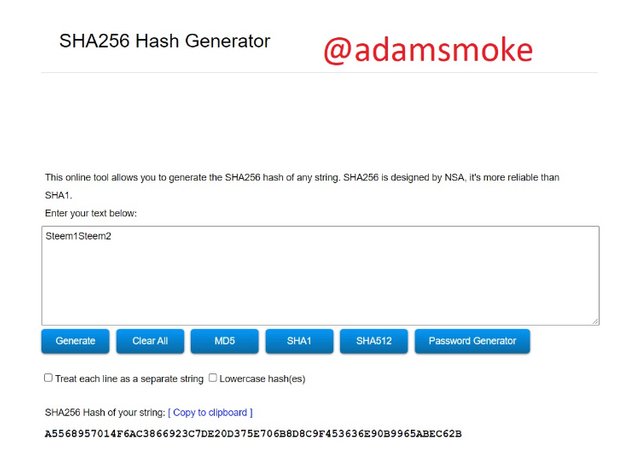
Steem3Steem4: 18D25196DB699F6AB9222B7302EB8A6F6EBFADEC703C07DD5DB8D9455913A499
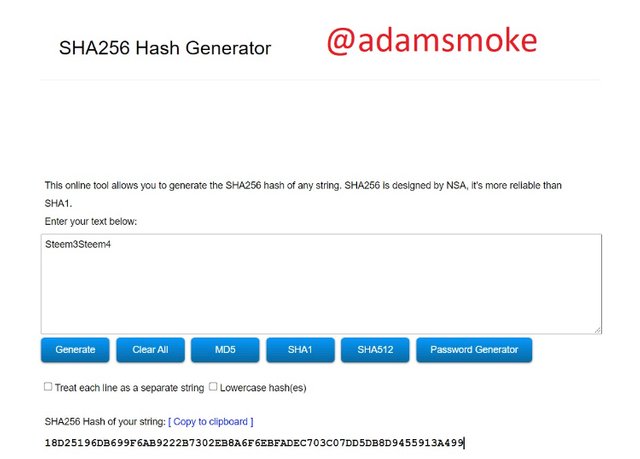
Steem5Steem6: D118E137F92A0DBEA138B6BF70C7714153A7BC393CD0272A44BD94864645224B
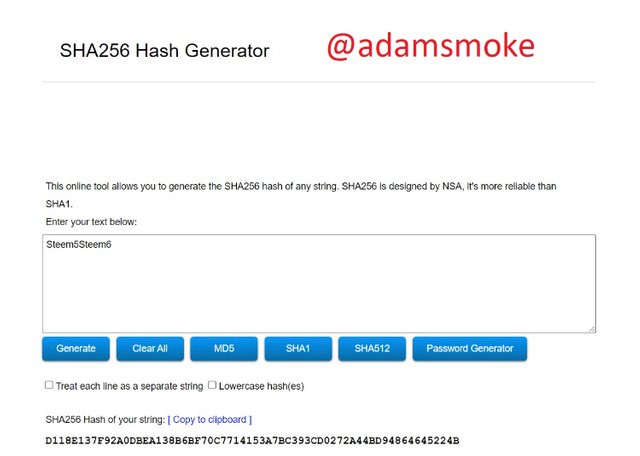
Steem7Steem8: A81D57BA11AEDFA9EFBBA42F6523D75D1EFA50B22C5E3557A21CEFFE87DDFC4A
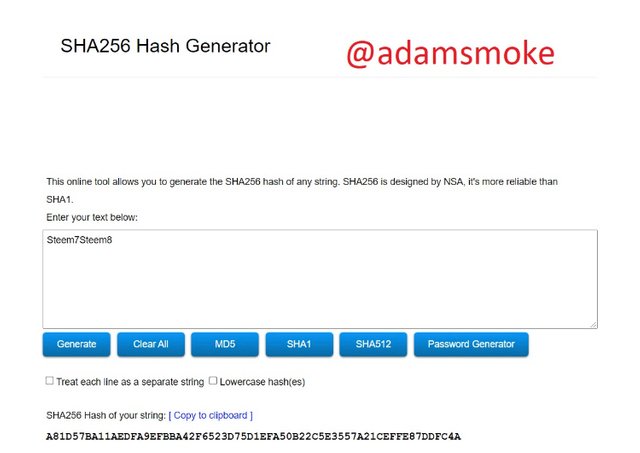
Second-level Merkle Tree Branches
Steem1Steem2Steem3Steem4: 8A248C05E69C4F1AA403AD18A7F445FF500C42483DA425CE0C980CDB2FD1AD9B
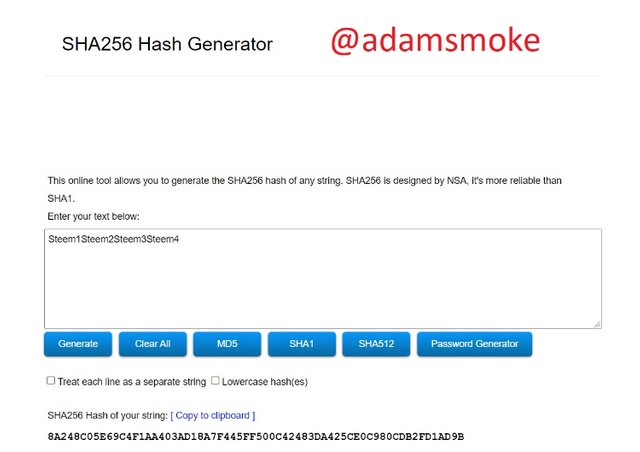
Steem5Steem6Steem7Steem8: 8B0935AEAB3F51BFA2B0750703EE2387E2B20EB19B0D24227E180C03A851AF17
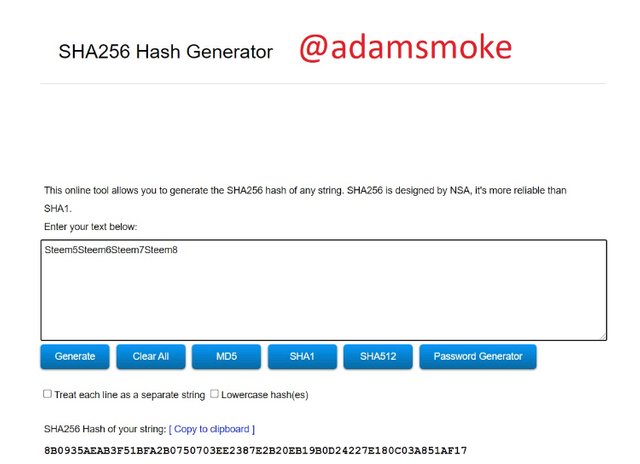
Merkle Tree Root Hashe<\center>
Steem1Steem2Steem3Steem4Steem5Steem6Steem7Steem8: 9C2FC83F36D59B8ED5033D2BCC417728583C8DAA0AA9868FD374BE3619D6E4F9
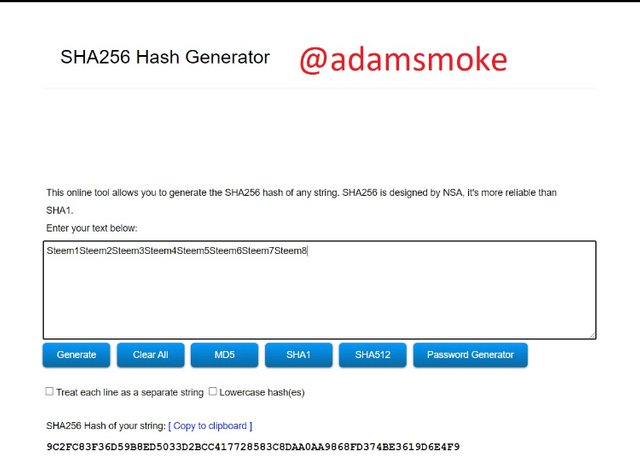
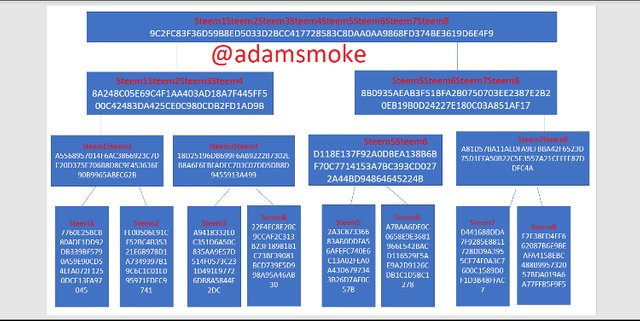
Steem6 Verification Steps
- First, steem5 is verified.
- Then Steem7Steem8 in our second branch is verified.
- After verifying Steem7Steem8, we move to our 3rd branch and the hash values of Steem1Steem2Steem3Steem4 on the other side are verified.
- In our last step, we reach our Steem1Steem2Steem3Steem4Steem5Steem6Steem7Steem8 value, which is the main root of our Merkle tree, where we can see the values of all our hash values.

Questions 3
3.- Usando el SHA-256; debes colocar cada hash completo en el Árbol Merkle.
Transacción (hojas del árbol): SCA1; SCA2; SCA3; SCA4; SCA5; SCA6; SCA7; SCA8. Explique cada paso, muestre captures de pantalla.
Si el número de las hojas del árbol es impar, ¿Qué debes hacer? Explique.
Merkle Tree
SCA1: 13E0A04BB0E669E1C638DBE3A704743F99F162B25245E4D8C064D35BA38FA8C8
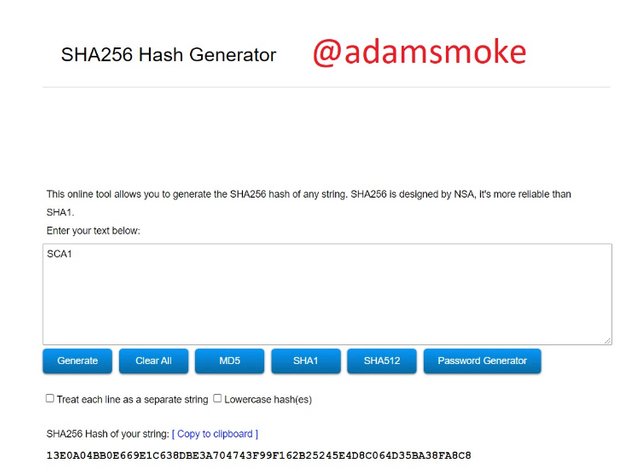
SCA2: 27849353A9C8CC4E948EB6E5748EDD79CB83513D8C0ADAF3E8C83D3792C9149B
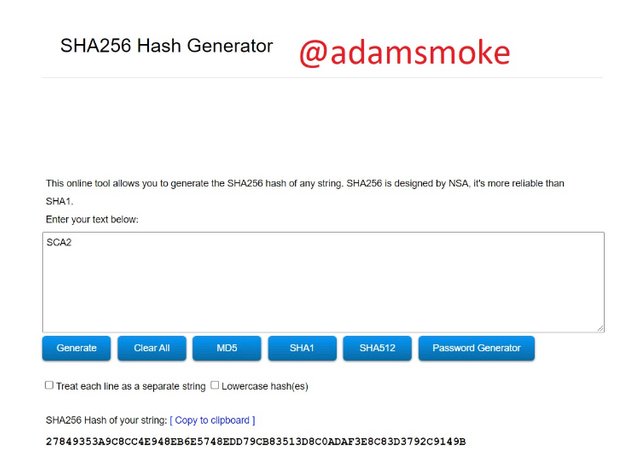
SCA3: 67E872F952C105C35E0BCE130536D061F4999DCA5593754BA9BA7BE59B8E7C0D
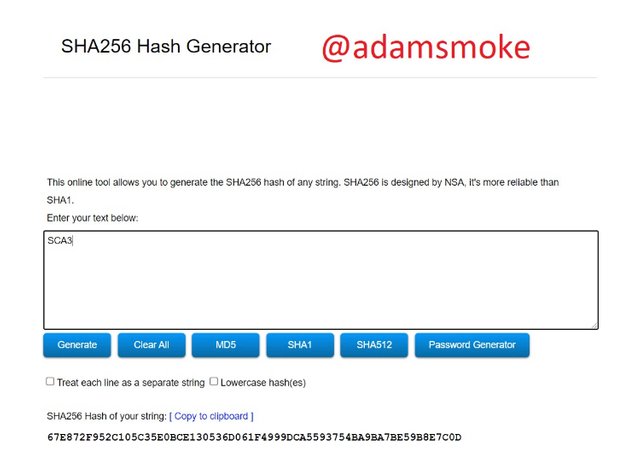
SCA4: 491928A32BAE70A12FA251412BBFD7C9999F317BA6BF577C283C724225270A43
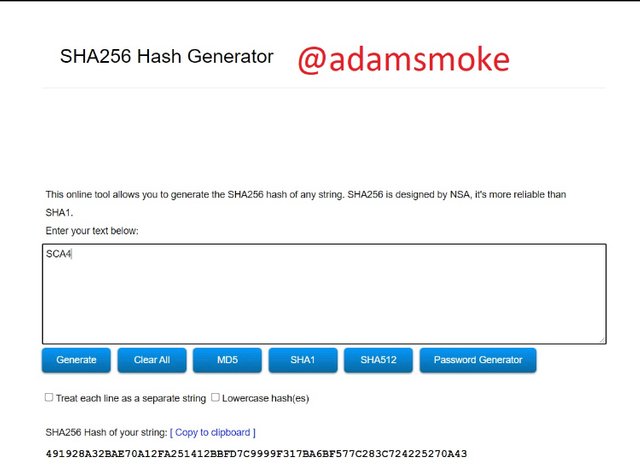
SCA5: 99C078C39CDE7F47799E0E8691460A9F3E83E78D498EA989308FCFCC58907B19
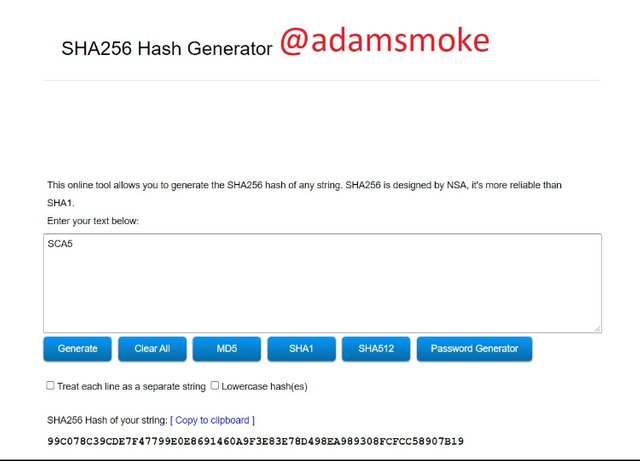
SCA6: 7A648D887B124DB14E96E23BA92783E7F26D00957C19B9B8229632C2C1873729
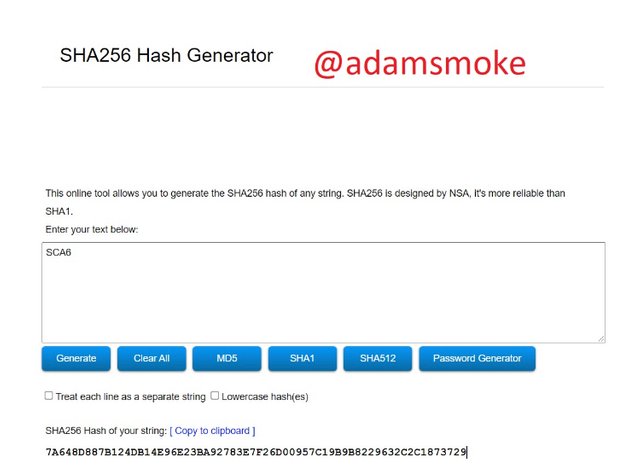
SCA7: 7E0BBD6BA4BA9896F9911AF46B06DD2C47535F9C80B29D693FDF6B9319D0D68E
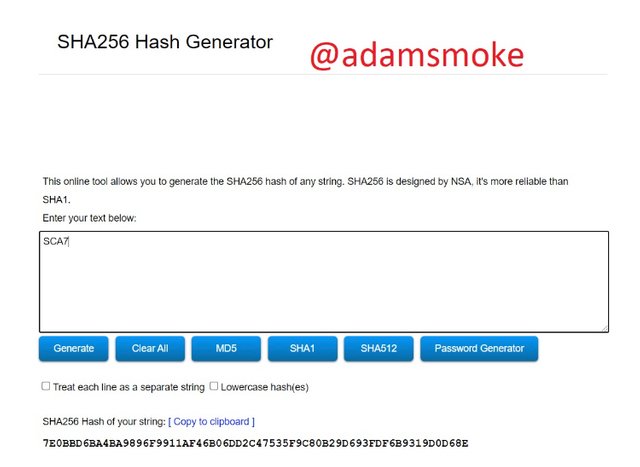
SCA8: 562ABCEEB497E1FE7AE275A883FD5EF9D92A05F5C19D82ABAA0DC1571B7DF3AD
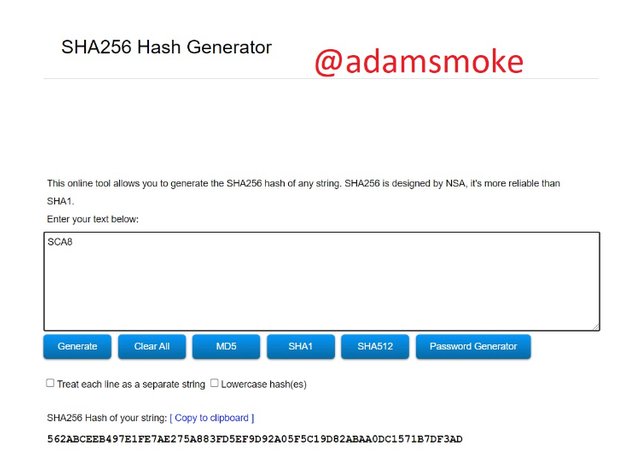
First Level Merkle Tree Branches
SCA1SCA2: 91B09BBA815748166FB36413342C7E4E7E809F4BAC538C0418841A4476B527EF
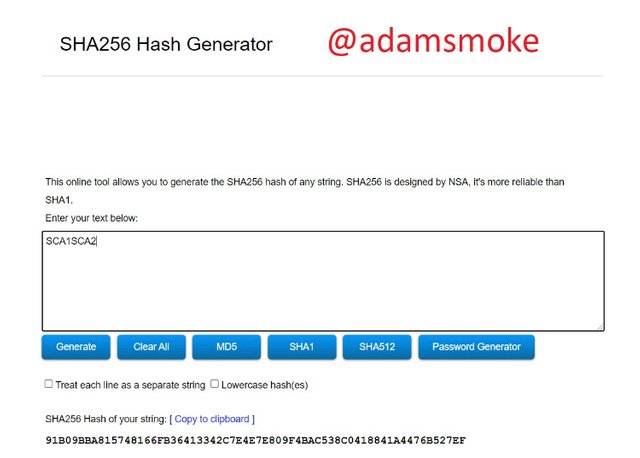
SCA3SCA4: B49B48697A3ACBC5E3D2E36B6EE49C44020D88E664C5C1AA7A7CF34058177379
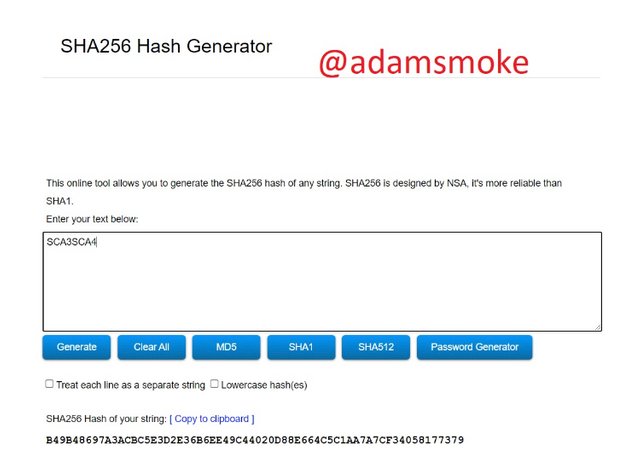
SCA5SCA6: F026924CD1285FF92C2A2DE9B9313027EB67273A82375C939348C887F6B52F77
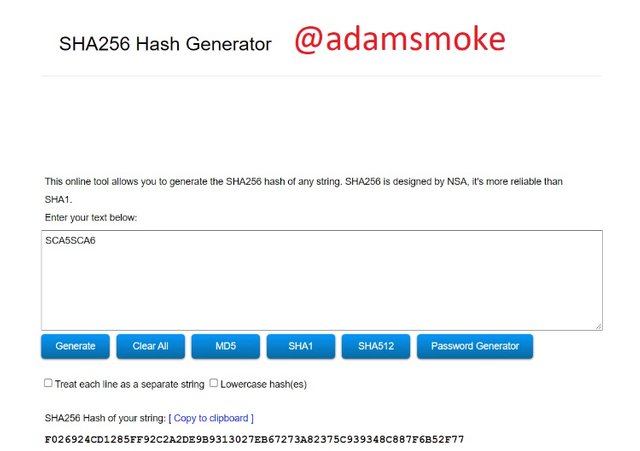
SCA7SCA8: AA55EC5A6B11393B289C4B2B6916172ACC2941C5C978FB1D7BF02696BAB323A4
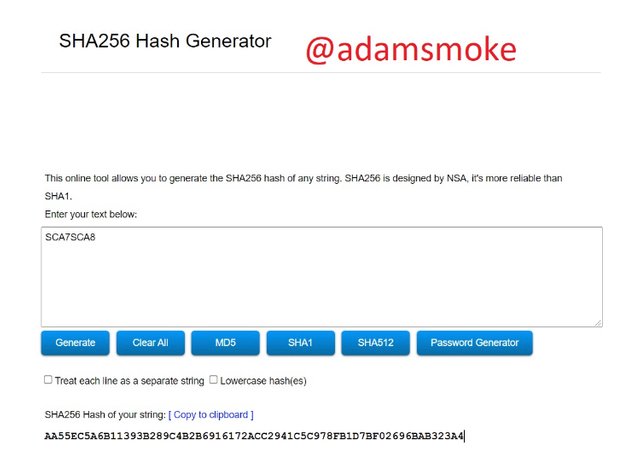
Second Level Merkle Tree Branches
SCA1SCA2SCA3SCA4: F50DC120CBF6C46923037F6D7F41D4153ECC9AB7430DDA662C142DB1FFE483F7
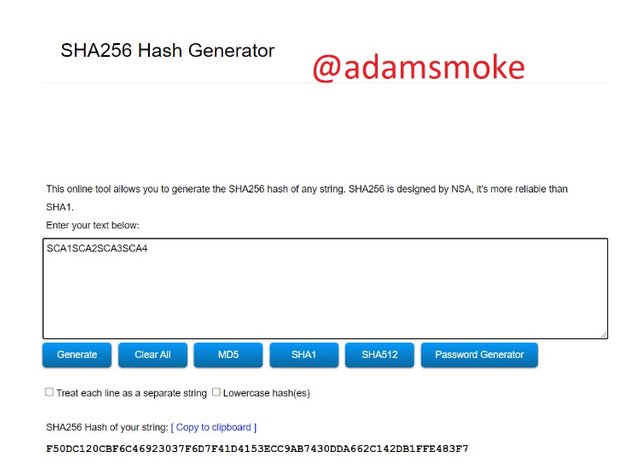
SCA5SCA6SCA7SCA8: A3D8CA8494CC426ABD5E1FC5FA0FEAE4F2B2ECE4C4CECDCA05E19EB66542533F
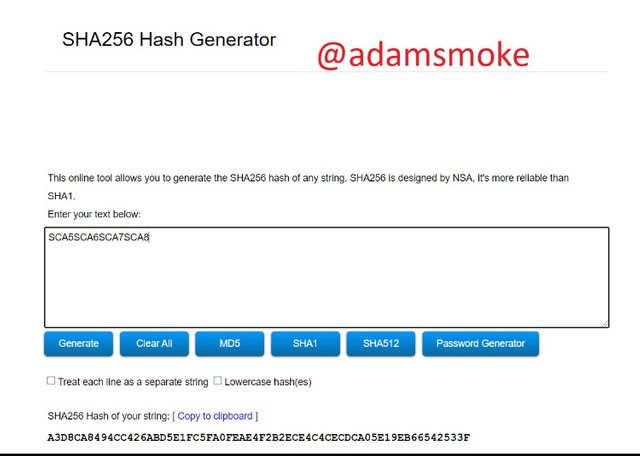
Merkle Tree Root
SCA1SCA2SCA3SCA4SCA5SCA6SCA7SCA8: CB40CA6DB72DD507CF9118963F94B7740822258E74AFB0FD45D89DB35D24B386
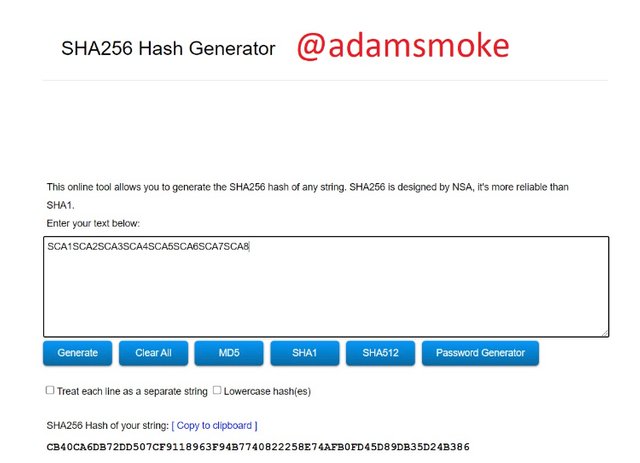
- The Merkle Tree, which we created thanks to all the leaves we found, is as in the screenshot below.
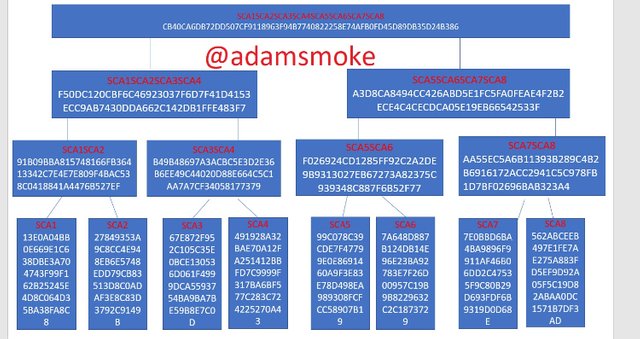
What happens when the number of leaves in a Markle tree is odd?
In the structure of the Merkle tree, the leaves that make up each branch must be present in pairs. Otherwise we will not be able to verify any branch of the tree. If there is a branch that is in the form of a single leaf in any way, we cannot reach our root hashe value.
If it is found as odd in any way, we can reach our root hash value by multiplying our non-pair hash value.
Example:
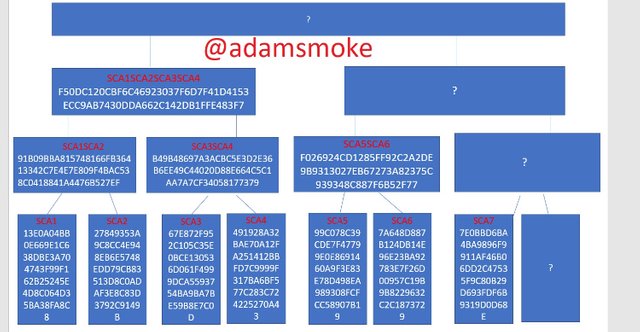
In case we encounter a Merkle Tree as in the figure;
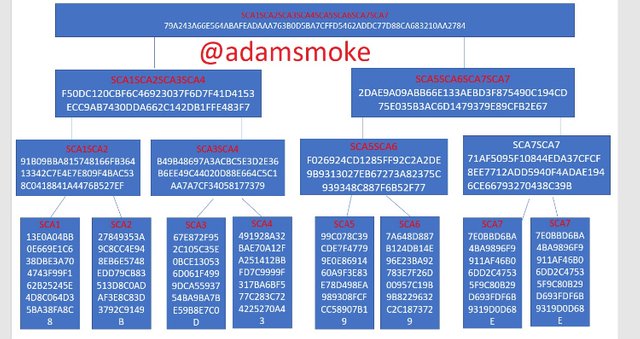
We multiply our Hash value in the form and make it double and we reach our root Hash value.

Conclusion
What is the hash rate in this lesson? and how to find merkle tree and merkle tree hash values in detail.
Thank you professor @pelon53 for this nice lesson.
Also, thank you again to everyone who read my homework.
CC: @steemitblog @pelon53
Steem1Steem2Steem3Steem4Steem5Steem6Steem7Steem8: 9C2FC83F36D59B8ED5033D2BCC417728583C8DAA0AA9868FD374BE3619D6E4F9


Steem6 Verification Steps
- First, steem5 is verified.
- Then Steem7Steem8 in our second branch is verified.
- After verifying Steem7Steem8, we move to our 3rd branch and the hash values of Steem1Steem2Steem3Steem4 on the other side are verified.
- In our last step, we reach our Steem1Steem2Steem3Steem4Steem5Steem6Steem7Steem8 value, which is the main root of our Merkle tree, where we can see the values of all our hash values.

Questions 3
3.- Usando el SHA-256; debes colocar cada hash completo en el Árbol Merkle.
Transacción (hojas del árbol): SCA1; SCA2; SCA3; SCA4; SCA5; SCA6; SCA7; SCA8. Explique cada paso, muestre captures de pantalla.
Si el número de las hojas del árbol es impar, ¿Qué debes hacer? Explique.
Merkle Tree
SCA1: 13E0A04BB0E669E1C638DBE3A704743F99F162B25245E4D8C064D35BA38FA8C8

SCA2: 27849353A9C8CC4E948EB6E5748EDD79CB83513D8C0ADAF3E8C83D3792C9149B

SCA3: 67E872F952C105C35E0BCE130536D061F4999DCA5593754BA9BA7BE59B8E7C0D

SCA4: 491928A32BAE70A12FA251412BBFD7C9999F317BA6BF577C283C724225270A43

SCA5: 99C078C39CDE7F47799E0E8691460A9F3E83E78D498EA989308FCFCC58907B19

SCA6: 7A648D887B124DB14E96E23BA92783E7F26D00957C19B9B8229632C2C1873729

SCA7: 7E0BBD6BA4BA9896F9911AF46B06DD2C47535F9C80B29D693FDF6B9319D0D68E

SCA8: 562ABCEEB497E1FE7AE275A883FD5EF9D92A05F5C19D82ABAA0DC1571B7DF3AD

First Level Merkle Tree Branches
SCA1SCA2: 91B09BBA815748166FB36413342C7E4E7E809F4BAC538C0418841A4476B527EF

SCA3SCA4: B49B48697A3ACBC5E3D2E36B6EE49C44020D88E664C5C1AA7A7CF34058177379

SCA5SCA6: F026924CD1285FF92C2A2DE9B9313027EB67273A82375C939348C887F6B52F77

SCA7SCA8: AA55EC5A6B11393B289C4B2B6916172ACC2941C5C978FB1D7BF02696BAB323A4

Second Level Merkle Tree Branches
SCA1SCA2SCA3SCA4: F50DC120CBF6C46923037F6D7F41D4153ECC9AB7430DDA662C142DB1FFE483F7

SCA5SCA6SCA7SCA8: A3D8CA8494CC426ABD5E1FC5FA0FEAE4F2B2ECE4C4CECDCA05E19EB66542533F

Merkle Tree Root
SCA1SCA2SCA3SCA4SCA5SCA6SCA7SCA8: CB40CA6DB72DD507CF9118963F94B7740822258E74AFB0FD45D89DB35D24B386

- The Merkle Tree, which we created thanks to all the leaves we found, is as in the screenshot below.

What happens when the number of leaves in a Markle tree is odd?
In the structure of the Merkle tree, the leaves that make up each branch must be present in pairs. Otherwise we will not be able to verify any branch of the tree. If there is a branch that is in the form of a single leaf in any way, we cannot reach our root hashe value.
If it is found as odd in any way, we can reach our root hash value by multiplying our non-pair hash value.
Example:

In case we encounter a Merkle Tree as in the figure;

We multiply our Hash value in the form and make it double and we reach our root Hash value.

Conclusion
What is the hash rate in this lesson? and how to find merkle tree and merkle tree hash values in detail.
Thank you professor @pelon53 for this nice lesson.
Also, thank you again to everyone who read my homework.